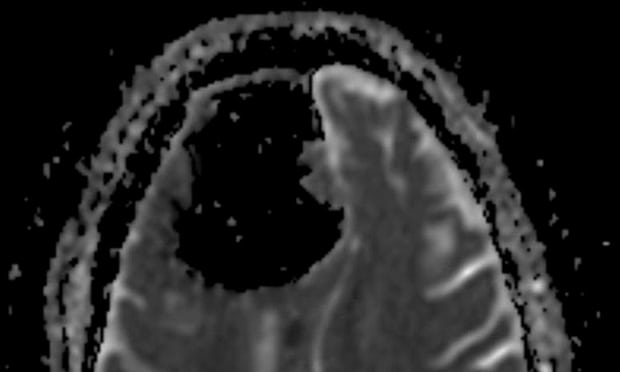The 84-year-old was referred to A&E by his doctor after several months of feeling unsteady on his feet and experiencing falls, and three days of weakness in his left arm and leg.
The details, published in the journal BMJ Case Reports, reveal that blood tests showed nothing out of the ordinary and there were no signs of facial weakness, speech problems or confusion.
But when the man was given CT and MRI brain scans, the medical team discovered an air-filled cavity measuring 9cm in his right frontal lobe. It also showed up a benign bone tumour, essentially a bony growth, within his nasal sinuses.
“[It] has been growing slowly over time and put pressure on the base of his skull causing a small erosion,” said report coauthor Dr Finlay Brown, a trainee GP who was part of the medical team involved in the case. “And subsequently because air goes through your sinuses, air is able to move through this and through the erosion into the skull.”
Brown said the eroded area and the tissue above it had formed a one-way valve. “The air can get in, but it can’t get back out again,” he said.
While the brain scan images appear as though a hunk of the brain has disappeared, Brown said that wasn’t the case; rather, the air cavity had compressed the brain.
“As the pressure builds, the wall of the skull isn’t going to move so the brain has to move,” he said.
The patient was offered the option of surgery to release the pressure in the brain, fix the erosion and remove the bone growth, but decided not to take it up given the possible risks. “It is a big surgery for anyone to have to fix that at any stage in their life,” said Brown.
While the authors note that the patient’s left-sided weakness had gone away after 12 weeks, what happens next is far from certain.
“In theory the brain could possibly absorb, or the body could reabsorb, some of the air, but it could also get worse. We just don’t know,” said Brown, adding that there was also a risk of infection or stroke. “He actually sustained a small stroke, probably due to the pressure effect over time, and there is I suppose a risk of that happening again.” Brown said the man had been given preventative treatment.
Brown said he had seen air in the cranial cavities of other patients and that it can occur as a result of trauma or infection. Some studies have suggested it is common among those who have had part of their skull removed during surgery, he said.
But, he added, the size of the air cavity in the latest case, and its organisation in one place, was remarkable.
“I have never seen anything like it,” said Brown. “I can’t imagine that I’ll ever see it again.”
More about: #Brain
















































